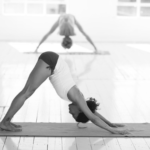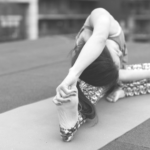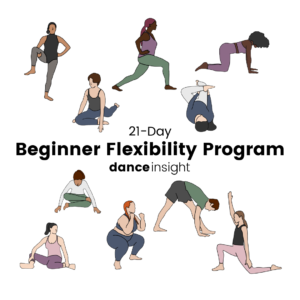
Static vs Dynamic Stretching for Dancers
Most people know what a static stretch is, even if they don’t realize they know it. But what’s a dynamic stretch? Is one kind better than the other? What are the best ways to incorporate them into your practice? We’ll talk about all of that below!
Read Stretching and Strength Training the Right Way, Part 1: Progressive Overload
What is Static Stretching?
Static stretches are what most people think of when they picture someone stretching. The basic gym class stretches, like pulling an arm across your chest or touching your toes, would be considered static. All of the stretches in Dance Insight’s 21-Day Stretching Challenge are static as well.
Any stretch that involves getting into a position and holding it is a static stretch. This may be the only kind of stretch you’ve been shown in your dance training. Splits, butterfly, straddle, cobra… they’re all positions that you hold for a certain amount of time in order to increase your flexibility.
Quick tips for static stretching:
- Never force yourself into a stretch that is extremely painful. A little discomfort is necessary to achieve results, but too much will lead to injury. Listen to your body and trust your instincts.
- Hold a static stretch for a minimum of 10 seconds* if you’re looking to increase your flexibility. (You can do less if you’re just warming up.)
- I don’t recommend holding a static stretch for more than 2 minutes. This study found that the greatest change in range of motion occured when participants held static stretches for 15-30 seconds.
What is Dynamic Stretching?
Dynamic stretches are stretches that involve movement. More specifically, it means the muscles that are getting stretched are also working to move your body. For example:
- Battements to your full extension (Hamstring gets stretched at the height of the kick, then works to pull the leg down)
- Lunges with your hands off the ground (Hip flexor gets stretched in the lunge while simultaneously working to keep you from collapsing)
- Releves on a stairstep (Calves get stretched as you lower your heels, then work to raise your heels up as you releve)
The simplest way to remember the difference is that if you’re moving, it’s a dynamic stretch, and if you’re not moving, it’s a static stretch.
Quick tips for dynamic stretching:
- Be careful of “whacking” your limbs into a stretch. (Example: laying on your back with your legs up and forcefully opening your legs to a middle split.) Even if you’re warmed up, “whacking” into a stretch is never a good idea. It puts too much jarring pressure on your muscles and could lead to injury. When you’re moving through dynamic stretches, make sure you’re controlling your body.
- Dynamic stretches don’t have to involve huge movements. Have you ever done a partner stretch where your partner gently pushes you down while you provide resistance? That’s a dynamic stretch, because you’re working and stretching your muscles at the same time!
When to Incorporate Static vs. Dynamic Stretching Into Your Routine
You might hear people say that dynamic stretching is better than static stretching overall. That’s an overgeneralization, and I haven’t found any scientific studies supporting it. Each type of stretching is good for different things!
Follow this simple rule: dynamic stretching is recommended during a warmup, while static stretching is recommended during a cool-down.*
There are exceptions, of course. You can do just fine warming up with static stretches, but dynamic stretches will do an even better job, especially if you’re about to do something highly physical.
Don’t get too caught up in choosing the exact, perfect stretch for your situation. As long as you’re choosing stretching over not stretching, you’ll probably be okay. Everything I’ve shared with you today is about optimizing your practice with little tweaks. If you’re just starting out on your dance journey, this isn’t something you should stress over!
Check out my 10-Minute Warmup for Dance Auditions for how to incorporate dynamic stretching into your warmup!
Check out my 21-Day Stretching Challenge for a series of beginner static stretches to increase your flexibility!
This is the scholarly article referenced several times above:
*Current Concepts in Muscle Stretching for Exercise and Rehabilitation, Phil Page, 2012







